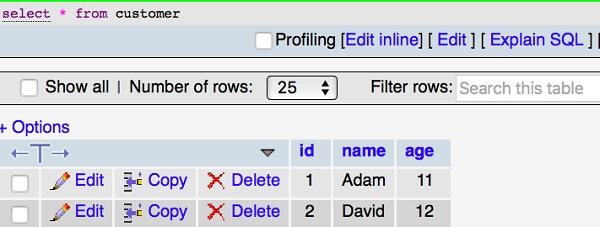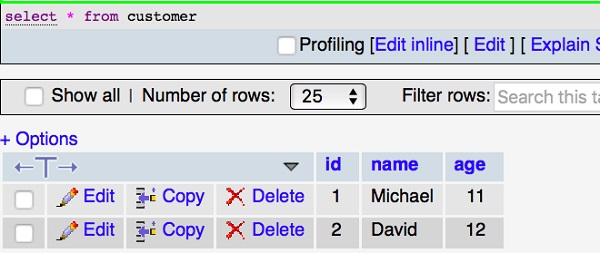
- TypeORM - Home
- TypeORM - Introduction
- TypeORM - Installation
- TypeORM - Creating a Simple Project
- TypeORM - Connection API
- TypeORM - Entity
- TypeORM - Relations
- TypeORM - Working with Repository
- TypeORM - Working with Entity Manager
- TypeORM - Query Builder
- TypeORM - Query Operations
- TypeORM - Transactions
- TypeORM - Indices
- TypeORM - Entity Listener and Logging
- TypeORM with JavaScript
- TypeORM - Working with MongoDB
- TypeORM with Express
- TypeORM - Migrations
- TypeORM - Working with CLI
- TypeORM Useful Resources
- TypeORM - Quick Guide
- TypeORM - Useful Resources
- TypeORM - Discussion
TypeORM - Query Operations
Data manipulation is used to manage and view data. This section explains about how to access database queries like insert, update, select and delete queries using QueryBuilder. Lets go through one by one in detail.
Build insert query
Let us create a Customer entity as follows −
Customer.ts
import {Entity, PrimaryGeneratedColumn, Column} from "typeorm";
@Entity()
export class Customer {
@PrimaryGeneratedColumn()
id: number;
@Column()
name: string;
@Column()
age: number;
}
Lets add the following changes in index.ts as follows −
index.ts
import "reflect-metadata";
import {createConnection} from "typeorm";
import {Customer} from "./entity/Customer";
import {getConnection} from "typeorm";
createConnection().then(async connection => {
await getConnection().createQueryBuilder() .insert()
.into(Customer)
.values([ { name: "Adam",age:11},
{ name: "David",age:12} ]) .execute();
}).catch(error => console.log(error));
Now, start your application using the below command −
npm start
Output
You could see the following output on your screen −

Now open your mysql server, table inserted with two fields as shown below −

Build update query
Last section, we have inserted two rows of data. Lets check how update query works. Add the following changes in index.ts as follows −
import "reflect-metadata";
import {createConnection} from "typeorm";
import {Customer} from "./entity/Customer";
import {getConnection} from "typeorm";
createConnection().then(async connection => {
await getConnection()
.createQueryBuilder() .update(Customer)
.set({ name: "Michael" }) .where("id = :id", { id: 1 }) .execute();
console.log("data updated");
}).catch(error => console.log(error));
Now, start your application using the below command −
npm start
You could see the following output on your screen −

Mysql table is modified as shown below −

Build select query
select query is used to display the records from the table. Lets add the following code in index.ts as follows −
index.ts
import "reflect-metadata";
import {createConnection} from "typeorm";
import {Customer} from "./entity/Customer";
createConnection().then(async connection => {
console.log("Display records from Customer table...");
const cus = new Customer();
console.log("Loading customers from the database...");
const customers = await connection.manager.find(Customer); console.log("Loaded users: ", customers);
}).catch(error => console.log(error));
You could see the following output on your screen −

where expression
Let us add where expression in the query to filter the customers. The sample code is as follows −
import "reflect-metadata";
import {createConnection} from "typeorm";
import {Customer} from "./entity/Customer";
import {getConnection} from "typeorm";
createConnection().then(async connection => {
const customer = await getConnection() .createQueryBuilder() .select("cus")
.from(Customer, "cus") .where("cus.id = :id", { id: 1 }) .getOne();
console.log(customer);
})
.catch(error => console.log(error));
The above program will return first id records. You could see the following output on your screen,

Similarly, you can try other expressions as well.
Build delete query
Last section, we have inserted, updated and select data. Lets check how delete query works. Add the following changes in index.ts as follows −
import "reflect-metadata";
import {createConnection} from "typeorm";
import {Customer} from "./entity/Customer";
import {getConnection} from "typeorm";
createConnection().then(async connection => {
await getConnection() .createQueryBuilder()
.delete()
.from(Customer)
.where("id = :id", { id: 1 }) .execute();
console.log("data deleted"); }).catch(error => console.log(error));
You could see the following output on your screen −

And your mysql table is modified as follows −
